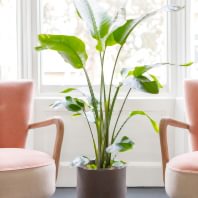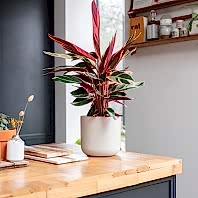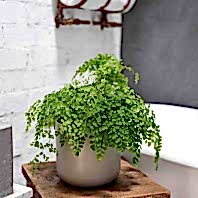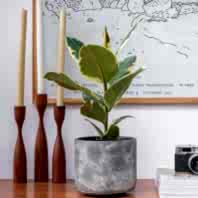Ficus elastica 'Tineke'
Rubber Plant 'Tineke'
The Rubber Plant Tineke is the variegated version of the Rubber Plant Roubsta. Native to Southeast Asia, the Tineke's leaves have splashes of cream, green and pink hues, making the perfect plant to bring some exotic colour into your home. The Rubber Plant Tineke is relatively easy to care for, and if kept in the right conditions, can grow up to three meters in height. We've also got a dark green version here.
Price match promise
Best quality plants guaranteed
Delivered to your door with care
Keep me in a bright room but out of direct sun rays. Be careful not to overwater me by allowing the top few cms of my soil to dry out inbetween waterings.
I like humidity, so mist me regularly to keep my foliage fresh.
Feed me once a month in spring and summer.
Wipe my leaves with a clean, damp cloth to free my pores from dust.
About Rubber Plant 'Tineke'
The Rubber Plant Tineke is a variant of the Rubber Fig botanically known as Ficus elastica. Its native habitat spans across Southeast Asia, from Nepal, Bhutan, northeastern India, Burma, China and Malaysia. Rubber Plants are widely grown in gardens across tropical regions of the world and during the '90s, they became an extremely popular houseplant in Europe.
In the wild, rubber plants can grow up to 40 metres in height. Rubber plants are part of the fig family and in the wild grow small white fig fruits. The Rubber Plant gets its name from the milky white latex it yields that can produce rubber, although is not used for commercial purposes anymore.
Rubber plants likes to be kept in a bright indirect light, but avoiding direct afternoon sunshine which can burn the leaves. The Rubber Plant does not tolerate drought well and likes its soil to be kept moist but not soggy. It's best to water as soon as the top few cms of soil have dried out. Being from tropical climes, rubber plants also enjoy extra humidity. Rubber Plant leaves tend to collect dust so its good to wipe them regularly to help absorb sunlight.
The incredibly strong root systems of rubber trees have been used to make bridges across rivers in India.
If ingested this plant can be toxic or poisonous so keep away from dogs, cats or other pets and small children.
Variegated Rubber Plant; Rubber Fig; Ficus Tineke; Ficus elastica; rubber bush; rubber tree; Indian rubber bush; Indian rubber tree
Based on 2 reviews

























